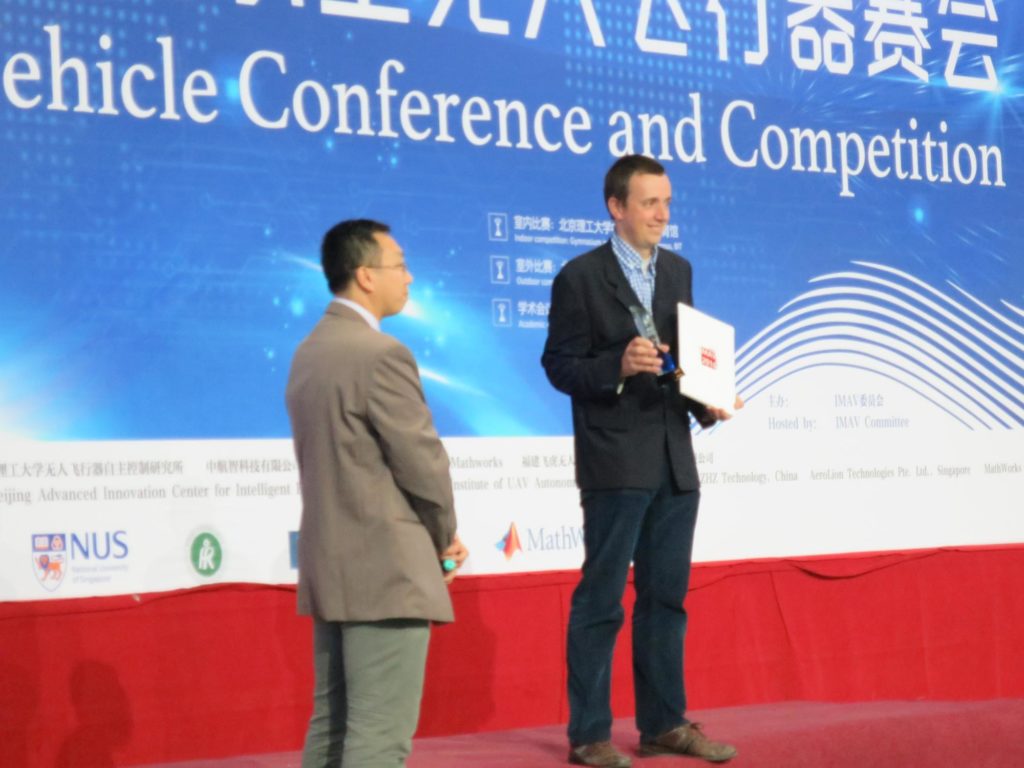In the week of October 17-21, the Micro Air Vehicle lab participated in the IMAV 2016 conference and competitions, which took place at the Beijing Institute of Technology (BIT), in China. This year, the competitions were focused on a search-and-rescue scenario, in which drones had to find survivors, deliver buoys (outdoors) and explore a building while retrieving some precious objects (indoors).

After a fierce competition, the MAV-lab obtained the 3rd prize in the indoor competition, and MAV-lab researchers Christophe De Wagter and Ewoud Smeur won the IMAV best paper award. In order to participate, we received support from the swarming theme of the Delft Robotics Institute.
Below, we go into detail into our performance in the different elements of the IMAV 2016 event.

Indoors
Indoors, the drones had to take off from a moving platform, fly into a house (either through a door or window), explore it from the inside to see what objects were inside, retrieve some precious objects, and return to the moving platform.
The focus of the MAV-lab was on the autonomous flight elements around the house, even on the very difficult grabbing task. In fact, TU Delft was the only team to try autonomous grabbing of the “precious” objects (in reality red and blue cans with a handle). TU Delft used a small, modified Parrot Bebop drone for this task. The modifications included the addition of a gripper and of longer “legs” – constructed with plastic chopsticks from the local cantine.
During training, the grabbing of objects worked perfectly, but during the competition run, the objects kept being blown away – probably because the object was dented by its use in the competition. Although the grabbing and dropping of objects did not work as well as during training, the team was still able to have the drone autonomously enter the house through a small window, fly around autonomously (with a combination of monocular vision and a few infrared sensors), and make a 3D map of the house indoors, identifying the relevant objects. Thanks to the small size of our drone (and hence the high difficulty of our participation), this gave us the third prize. Below you can see a video that shows some of the indoor mission elements.
Outdoors
Outdoors, the drones had to take off from a moving platform, search for a survivor in a search area, drop a buoy close to a survivor, get a water sample from a lake, drop it in a container, and land again on a moving platform.
TU Delft’s approach to this mission was to perform it fully autonomously with a small, modified Parrot Bebop drone. The modifications included a buoy drop and water sampling and drop mechanism. In addition, the software controlling the drone was completely replaced by the Paparazzi software.
Unfortunately, we had some serious difficulties outdoors because of a broken WiFi transmitter / receiver. Due to this issue, we were not able to fly far away from the ground station, which seriously hampered our participation – ending much lower than other teams that did perform all mission elements.
Best paper award
Two members of the MAV-lab, Christophe De Wagter and Ewoud Smeur, also won the best paper award at the IMAV 2016, for their paper: “Control of a hybrid helicopter with wings,” in International micro air vechicle competition and conference 2016, Beijing, PR of China, 2016, pp. 87-94. The paper was praised for the solution of the difficult control problems related to the new hybrid UAV design the “DelftaCopter”.
IMAV 2016 team
- Kirk Scheper (team leader)
- Kimberly McGuire
- Wilco Schoneveld
- Suresh Sharma
- Junhyeon Lee
- Federico Paredes-Valles
- Matej Karasek
- Christophe De Wagter
- Bart Remes
- Guido de Croon
